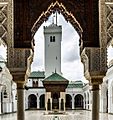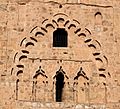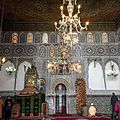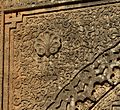Moroccan architecture facts for kids
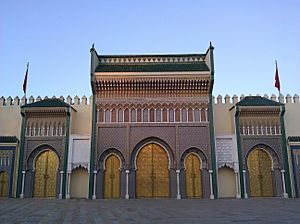
Moroccan architecture is all about the amazing buildings and designs found in Morocco. These buildings show off a mix of styles from different times. They tell the story of the people who lived there, from the first Berber settlers to Arab groups and later, Europeans.
The oldest style is Berber architecture, which was already there. Then, when Arab groups arrived, they brought Islamic architecture. This blend created the unique Moroccan style we see today. It's like a cool mix of history and art!
Contents
What is Moroccan Architecture?
Moroccan architecture is a special way of designing buildings. It uses ideas from different cultures. These ideas came from people who settled in Morocco over many centuries.
Influences on Moroccan Buildings
Morocco's location has made its architecture very rich.
- Berber people: They were the first people to build in Morocco. Their style often used local materials like earth and stone.
- Arab people: When Arab groups came, they brought Islamic building styles. This included beautiful patterns and designs.
- European influence: Later, Europeans also added their own touches. This happened especially in cities like Casablanca.
Key Features of Moroccan Architecture
Moroccan buildings often have special features. These make them stand out.
Beautiful Patterns and Designs
You'll see lots of amazing patterns in Moroccan buildings.
- Zellij: This is colorful tilework. Small pieces of tile are cut and put together like a puzzle. They form geometric shapes and stars.
- Carved wood: Wood is often carved with detailed designs. You might see this on ceilings or doors.
- Stucco: This is a type of plaster. Artists carve it into fancy patterns on walls.
- Calligraphy: Beautiful Arabic writing is often used as decoration. It usually features verses from the Quran.
Unique Arches and Domes
Moroccan architecture uses special shapes for doors and windows.
- Horseshoe arches: These arches are rounded at the top, like a horseshoe. They are very common.
- Polylobed arches: These arches have many small curves, making them look like a series of connected lobes.
- Muqarnas: This is a cool 3D decoration. It looks like many small niches or honeycombs. You often see it in domes or archways.
Courtyards and Gardens
Many traditional Moroccan homes and palaces have hidden courtyards.
- Riads: These are traditional Moroccan houses. They have an inner garden or courtyard. This space is peaceful and private.
- Fountains: Courtyards often have a fountain in the middle. This helps keep the air cool.
Famous Moroccan Buildings
Morocco has many famous buildings that show off its unique style.
Mosques and Madrasas
Mosques are places of worship for Muslims. Madrasas are schools for religious studies.
- Koutoubia Mosque: In Marrakesh, this mosque has a tall, beautiful minaret. It was built in the 12th century.
- University of al-Qarawiyyin: Located in Fes, this is one of the oldest universities in the world. Its mosque has a 10th-century minaret.
- Ben Youssef Madrasa: In Marrakesh, this old school is famous for its detailed decorations.
Kasbahs and Palaces
Kasbahs are old fortresses or walled towns. Palaces are grand homes for royalty.
- Aït Benhaddou: This is a famous ksar (a fortified village) in the mountains. It's made of earth and looks like a sandcastle.
- Bahia Palace: In Marrakesh, this palace has amazing carved ceilings and courtyards.
- Royal Palace in Fes: This palace shows off beautiful Islamic architecture.
Gates and City Walls
Old Moroccan cities are often surrounded by strong walls and grand gates.
- Bab Mansour: This is a huge, decorated gate in Meknes. It's one of the most impressive gates in Morocco.
- Bab Bou Jeloud: In Fes, this gate was built by the French in 1913. It has a beautiful "Moorish" style.
Modern Moroccan Architecture
Even today, new buildings in Morocco often use traditional ideas.
- Marrakesh Menara Airport: The new part of this airport, built in 2008, mixes modern design with traditional Moroccan patterns.
- Bank al-Maghrib: This bank in Rabat was built in 1930. It has a mix of modern and traditional Moorish styles.
Moroccan architecture is a living art. It continues to grow while honoring its rich past.
Related pages
Images for kids
-
A traditional Moroccan townscape in Chefchaouen
-
The minaret of the Kutubiyya Mosque in Marrakesh, built under the Almohads in the 12th century
-
The ksar of Ait Benhaddou, in the southern High Atlas mountains of Morocco
-
The 10th-century minaret of the al-Qarawiyyin Mosque, in Fes (seen through the arches of the later 16th-century Saadian pavilions)
-
A carved and painted wooden ceiling in the Bahia Palace (late 19th to early 20th century)
-
The courtyard (sahn) of the Great Mosque of Kairouan, in present-day Tunisia, founded in 670. Kairouan was one of the centres of power and culture in early Islamic North Africa.
-
Interior of the Kasbah Amridil in Skoura, a restored example of an oasis kasbah, originally built in the 17th century
-
Example of carved stucco with calligraphic decoration in the Bou Inania Madrasa of Fes
-
The dome of a hammam room in the Bahia Palace of Marrakesh
-
A khettara emerging at the surface near Rissani (Tafilalt region)
-
A riad garden in the 19th-century Bahia Palace of Marrakesh
-
Alfred Bel's sketch of one of the gallery facades of the courtyard of a 14th-century house, studied in 1914 right before its demolition. The house contained many classic elements of later Moroccan houses and its decoration was similar to that of Marinid madrasas of the time.
-
A traditional house in Fes (serving as a carpet shop today), with a classic two-story gallery with large central openings flanked by smaller side arches
-
The Sqala of the Port in Essaouira
-
A sebka or darj wa ktaf motif on one of the facades of the Hassan Tower in Rabat
-
Sebka motif filled with arabesques in the carved stucco decoration of the Ben Youssef Madrasa
-
Geometric patterns in zellij tilework at the Al-Attarine Madrasa in Fes
-
Geometric motifs on the bronze plating of the doors of the Al-Attarine Madrasa
-
Geometric patterns in a wooden ceiling in the Ben Youssef Madrasa in Marrakesh
-
Late 12th-century Kufic inscription carved into stone on the Almohad gate of Bab Agnaou in Marrakesh
-
Kufic script with ornamental flourishes, painted on tile
-
Arabic calligraphic inscription carved into stucco in the early 14th-century al-Attarine Madrasa in Fes
-
Arabic calligraphic inscription carved into wood in the early 14th-century Sahrij Madrasa in Fes, surrounded by other arabesque decoration
-
Muqarnas carved in wood in the Dar al-Makhzen of Tangier
-
A tighremt in Ait Benhaddou with decoration






